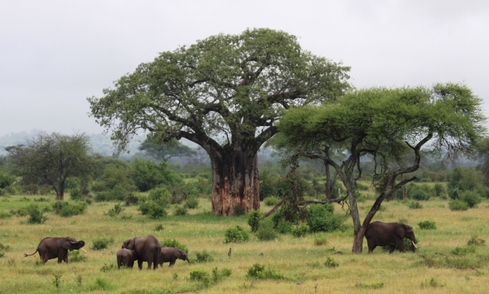 Tarangire National Park is world-famous for its high density of baobab trees, one of the most interesting and unusual trees on the planet. Monumental in size, bizarre in shape, and extraordinary in function, these trees are highly adapted to survive under quite extreme environmental conditions, including drought, fire, and the voracious and not-so-gentle appetites of elephants. Baobabs are undoubtedly the biggest trees in our study area. One of the largest baobab trees in Africa occurs on the coast of Kenya and its girth measures almost 30 meters! But they are not necessarily the most massive by volume – the larger baobabs actually have hollow trunks, or trunks filled with decomposing debris. Its great size is necessary to keep it standing, because its wood structure is not strong. In most other trees, the living tissue that transports water and nutrients is located between a tough, protective outer layer of bark and the softer internal wood. In the baobab, however, the living tissue comprises the entire trunk. There is no bark and there is no wood – it is all one.
Why would this be so? This unique structure ensures that fires and elephants cannot destroy all the living tissue. No matter how much an elephant gouges the tree trunk or rips off pieces with its tusks, or how intensive a fire burns, there is always living tissue behind the damaged area that continues functioning. The wood is also pithy, allowing the tree to uptake and store massive amounts of water from rainy season deluges through their shallow root system. This water-uptake system enables baobabs to maximize the time their leaves remain active before they dry up and fall off during the dry season (called “drought-deciduous”). Many animals seek out the baobab tree for shelter, including leopards and other smaller cats, and the trees are favorite nesting places for hornbills, birds of prey, and bees. Even giraffes will occasionally feast upon the leaves. Their lovely flowers (closed during the day to retain moisture) open at night and release a strong scent, attracting bushbabies and fruit bats seeking sweet liquid located in a juicy swelling in the flower stalk. As these mammals bury their faces in the flower to drink, the pollen brushes their muzzles. They carry the pollen to another flower and deposit it during their next meal, and the baobab flower is pollinated, leading to seed and a fruit pod – and eventually another extraordinary baobab tree.
0 Comments
Your comment will be posted after it is approved.
Leave a Reply. |
Science News and Updates From the Field from Wild Nature Institute.
All Photos on This Blog are Available as Frame-worthy Prints to Thank Our Generous Donors.
Email Us for Details of this Offer. Archives
July 2024
|
|
Mailing Address:
Wild Nature Institute PO Box 44 Weaverville, NC 28787 Phone: +1 415 763 0348 Email: [email protected] |
|



 RSS Feed
RSS Feed
